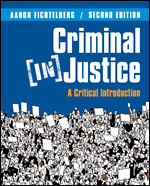You are here
Strategies for Engaging Students in Critical Thinking
Criminal Justice expert and Professor Aaron Fichtelberg discusses 3 strategies for engaging your students in critical thinking.
By Aaron Fichtelberg, author of Criminal (In)Justice: A Critical Introduction, Second Edition

A few years ago, a colleague asked me over lunch what I meant when I described Criminal (In)Justice as a “critical” introduction to the topic? I explained that you can’t truly understand the American criminal justice system if you separate it from the broader social order that it’s a part of, especially the inequalities that are endemic to that order.
Further, it is essential in understanding the criminal justice system to recognize that it often supports that unjust order upholding inequalities in the name of “upholding the law”.
Of course, my colleague is a sophisticated scholar, and he knows what it means to be critical in social science. He asked because he himself was writing a book on critical thinking in sociology, but he used the term in a very different way. For him, to be “critical” meant avoiding naïve or dogmatic thinking about society—including dogmatic thinking on both the right and the left.
I’ve thought a lot about that conversation since, because I think our different views about being critical are both valuable, though they are clearly different. Equally, both forms of critique are important parts in the social scientist’s toolkit, tools that are both important for teaching criminal justice, particularly in an introductory course. That is to say that criminal justice professors must be critical in both senses – understand the social context in which criminal justice operates and avoid dogmatic thinking about social science from all sides.
When I teach introduction to criminal justice, I understand that students come in with very strong preconceptions about the material. Some, usually because they have been exposed to too much TV or too many podcasts, eagerly await gory discussions of serial killers or a class immersed in the rhetoric good and evil, law and order. Others probably dread the class for that same reason, fearing that the course will be a lesson in right-wing, pro-police dogma. When they learn about my critical perspective on the first day, many are disappointed, though some are relieved. (I often quip on the first day that you’re more likely to be killed by a falling refrigerator than a serial killer and you’re certainly more likely to be killed by what’s in your refrigerator.)
In my experience, many students taking a criminal justice course are very skeptical about critical approaches, especially when the right wing has so thoroughly politicized the idea of critical theory. It’s very easy for students to write off a critical approach as the stereotypical left-wing academic forcing their “liberal agenda” down the throats of students and indoctrinating them into an “anti-cop” ideology. Conservative media has done a great job over recent years of “inoculating” many of my students to the possibility of a critical perspective by attacking what we academics are believed to represent--arrogant, condescending leftists who do not respect the beliefs, the values, and the faith of “real Americans”.
In short, there is a lot to do in an introductory criminal justice course, including a lot of assumptions, preconceptions, and ideological barriers to get through. Most often, I don’t see it as my job to convince my students that the critical approach to criminal justice is the best one, but rather to open them to that perspective, to get them to think differently about crime, law, and order, and let the material do the rest of the work. To get them to open in this way, I’ve developed a few principles to guide my teaching. Most of these are broad rules of thumb rather than straightforward rules, but they’ve helped me a lot in my teaching over the years.
Respect your students
Some of my favorite students over time have been students whose politics are diametrically opposed to my own. As soon as they realize that I’m going to engage with them respectfully and neither dismiss their views nor condescend them, they can engage intellectually with the course. A lot of this means just taking their view seriously and conceding that the conservative perspective represents an intellectually serious point of view (as opposed to dismissing it as racist, biased, or nonsense), and expresses the sincerely held views of many people. This lets students know that they have a perspective that is worth considering and worth taking seriously.
Provide data
So much of the popular understanding about crime is based on myths or armchair psychology. While data can always be misleading it can also be a very effective tool for making a point. For example, when crime data is juxtaposed to sentencing data, and it becomes clear that crime rates bear no relation to incarceration rates, it’s pretty hard to say that crime and punishment are really connected in our society. “Data” doesn’t have to be quantitative material in chart form: historical examples regarding the evolution of prisons or the post-Civil War Black Codes provide great historical examples of the links between criminal justice and racial oppression that can undermine widespread myths about the police or prison. If you have the facts on your side, they can do a lot of talking for you.
Build trust. Approach the topics with humility
No single approach is right and there are times when you don’t know things (or even get things wrong in class). Understanding and admitting the limits of what you know is important because it helps build trust with students. Admitting your mistakes and your limitations is crucial.
I tried to write Criminal (In)Justice in a conversational voice; I wanted to open students up to seeing the world through a critical lens. For many students this requires letting go of a lot of what they’ve learned on TV, movies, and podcasts: That there’s a world full of evildoers (drug dealers, serial killers, muggers) and the criminal justice system represents the line of protection between order and chaos. Letting go of that belief is very difficult for many young people. Forcing critical insights onto students in a dogmatic way is both uncritical and ineffective because students shut down when they feel their voices aren’t being heard. By approaching these topics with respect and humility, students are much less likely to perceive your approach as a threat and to examine the material on its own terms and (hopefully) come to critical conclusions on their own. But it can’t be forced.
There are limitations to this approach. Undeniably, I am given a lot more credibility and legitimacy as a heterosexual, cisgender, white male than would a teacher who didn’t occupy such a privileged social position. Faculty from other backgrounds must deal with many challenges that don’t confront me in the classroom. I hope that faculty from these different backgrounds will find ways to adapt these principles to their own classroom in their own way. Being critical in both senses means being open to different points of view and having the courage of your convictions.
I truly believe that to be truly critical in your thinking and your teaching is to understand the limits of the present. Empirical research can only tell us so much—it can point to problems in our current reality, and even suggest ways to solve them, but data can’t alone invite us to envision a new, different, and better world. This new world requires imagination, art, poetry, and even religion, but when we are open in the classroom and engaging with our students in a critical way, we are pointing our students into a new direction. Even in the rough and tumble world of crime and criminal justice, it is possible to imagine a better, more just, and even more beautiful society, and the classroom can sometimes be the first step on the path to that world.

